I love night rides, but I hadn’t ridden any recent lights until I got the MB6 from Full On Lighting this spring. With a maximum output of 6000 lumens, I was wondering if it would be too much! My older setup is a 1500 and a 500 lumen light combo, which I was always happy with. I was stoked to see what the MB6 would be like with its impressive output.
I wondered if this powerful light would actually take some of the fun out of night riding, but it did not. Even at full power, the MB6 doesn’t dilute the unique feeling of shredding at night – it just offers better visibility. Functionally, the MB6 was almost perfect, but its only weakness was not achieving its claimed run time in its highest output mode.
Full On MB6 Light – In The Box:

The MB6 light comes with a full kit of everything you need to mount the light to your stem or helmet. In the box, you’ll find the MB6 light, battery, and a wall charger. You also get two 48” long USB-C cables, one 21” USB-C cable, a GoPro-type mount for the light, an aluminum steerer tube mount, a strap for mounting the battery, two adhesive mounting plates, and two adhesive cable clips. There is also a one-page quick start guide, with basic instructions and a QR code you can scan to access more details.
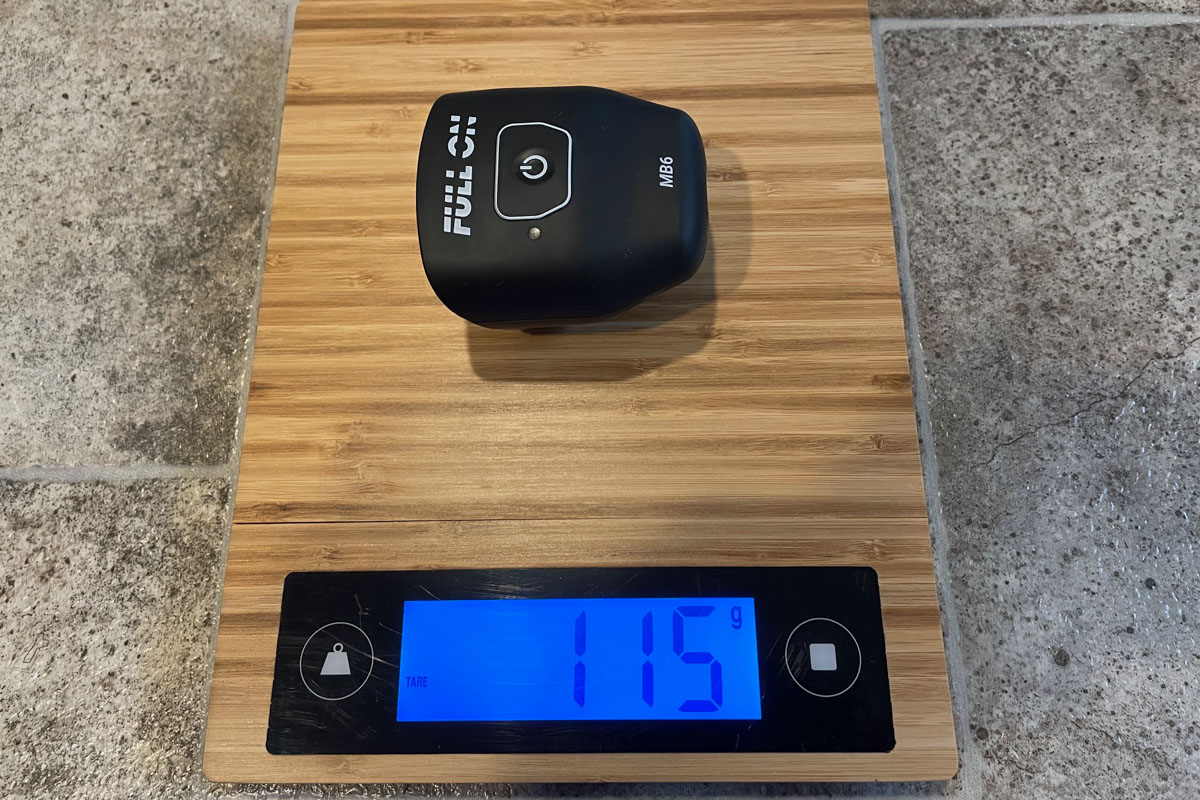
At 115g, the MB6 light itself is quite lightweight, so it’s great for a helmet light in that regard. The battery weighs 401g, and the complete kit, as ridden (including mount, cable, hardware), came in at 568g.
Operation:
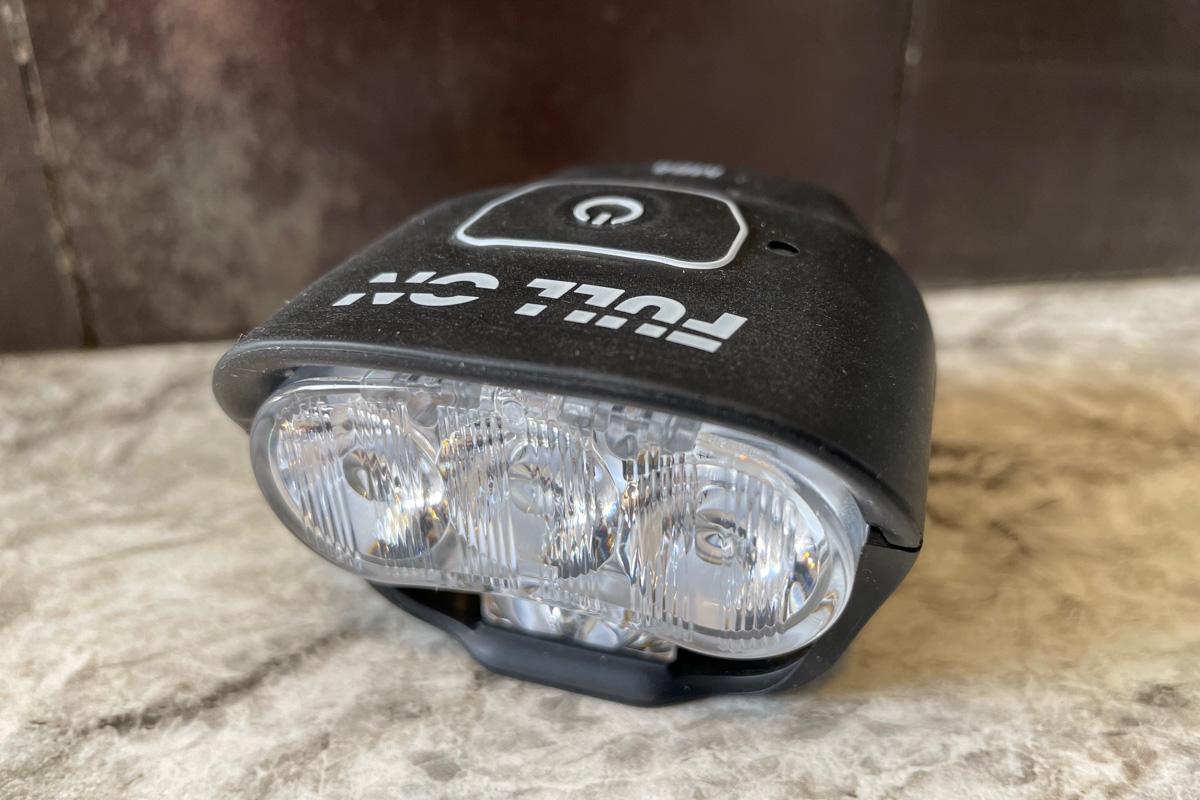
Operating the MB6 light is simple. The single button on top of the light acts as the power switch and mode selector. One press of the button turns the light on, then subsequent presses toggle between modes. A long press shuts off the light.
The MB6 offers four light output levels: Hangout mode (275 lumens), Manual Low (1500), Manual High (3800), and Active Light Control (ranges from 1500-6000 lumens automatically). Hangout mode uses only the small light below the top three, and all other modes use all four lights together. A small LED light on top of the light changes color to indicate what setting you’re in.
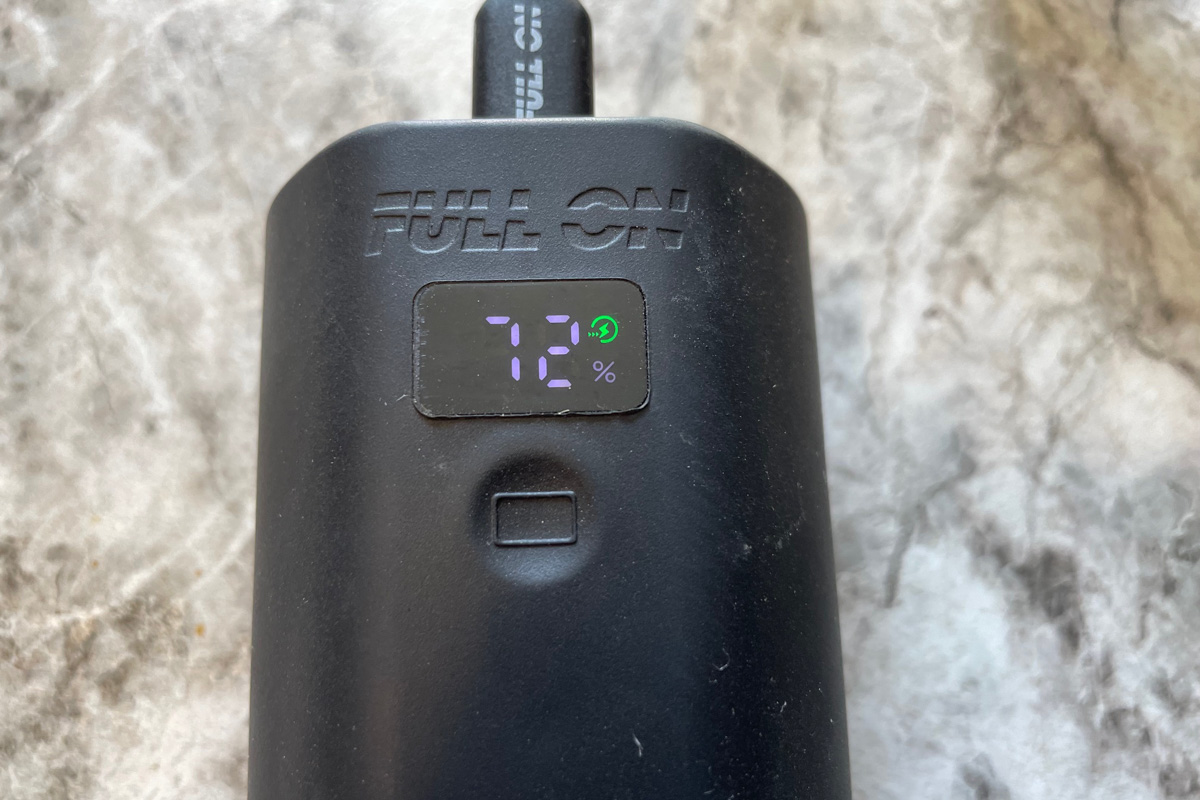
The battery features a small screen that shows its life by percentage. The display is very easy to see and understand, with the battery mounted on your top tube. However, if the light is on your helmet and the battery is in your backpack, you obviously can’t see the display.
After several battery charges, I can assure you that Full On’s claim of a two-hour charge time is accurate.
Ride Impressions:
First, I’ll confess: I climbed, but never descended with the MB6 in Manual Low mode. That mode’s output only matches my older Serfas True 1500 light, and the MB6 can do much better. However, 1500 lumens is adequate to ride with, especially when climbing or when paired with a second light, so it’s great to have the option of extending the MB6’s battery life with this mode.
MB6 on Helmet:

On my first ride, I rode to the trailhead with my Serfas True 500 light on my handlebars and the MB6 on my helmet in hangout mode. Even in this mode, the light brightens up a nice area around you, so it was ample to get me through town and to the trail.
Entering the forest, I switched the MB6 to Low mode. On my helmet, I found the MB6 provided enough light for climbing at just 1500 lumens. I had more than enough trail visibility for low-speed pedalling, and the MB6’s wide beam lights up a broad area. Since a helmet-mounted light always shines where you’re looking, I found this setup preferable over running the MB6 on my stem in the same mode.
Given that Low mode is already sufficient for climbing, it’s obvious that the Manual High and Active Light Control modes provide better and even better visibility. Manual High mode increases the short-range definition, distance, and overall area you can see considerably vs. Low, and going to Active Light Control (ALC) mode provides a ton of light. All modes from Low to ALC illuminate the same broad area, but the brighter modes definitely increase your peripheral visibility. To ensure great trail visibility, the MB6’s center beam is a bit brighter than the side beams.

ALC mode could be called overkill for climbing, but if you want all the light available, it does a great job of showing you every detail of the trail ahead. The MB6 also projects pretty far in ALC mode – I could easily see things 70-80 feet away. Using the MB6 on its own, I think Manual High mode is the best choice for climbing.

Descending in Manual High with the MB6 on my helmet easily provided enough light for proper trail shredding at night. 3800 lumens will allow you to ride without hesitation, showing you plenty of trail ahead and illuminating a nice area around you as well. Having the light on your helmet naturally provides earlier visibility around corners, and can illuminate trail obstacles that are below you as the light goes directly where you’re looking.
The MB6’s full power ALC mode is super bright and makes riding in pitch black conditions no problem at all. Short-range visibility is excellent, and you can easily see far enough down the trail for any riding speed. The light pretty much covers your entire field of view, so you don’t feel like you’re following a spotlight down the trail. On a helmet, the MB6 alone in ALC mode should allow you to ride anything you’d ride in the daytime, at 100% speed!
MB6 on Stem:
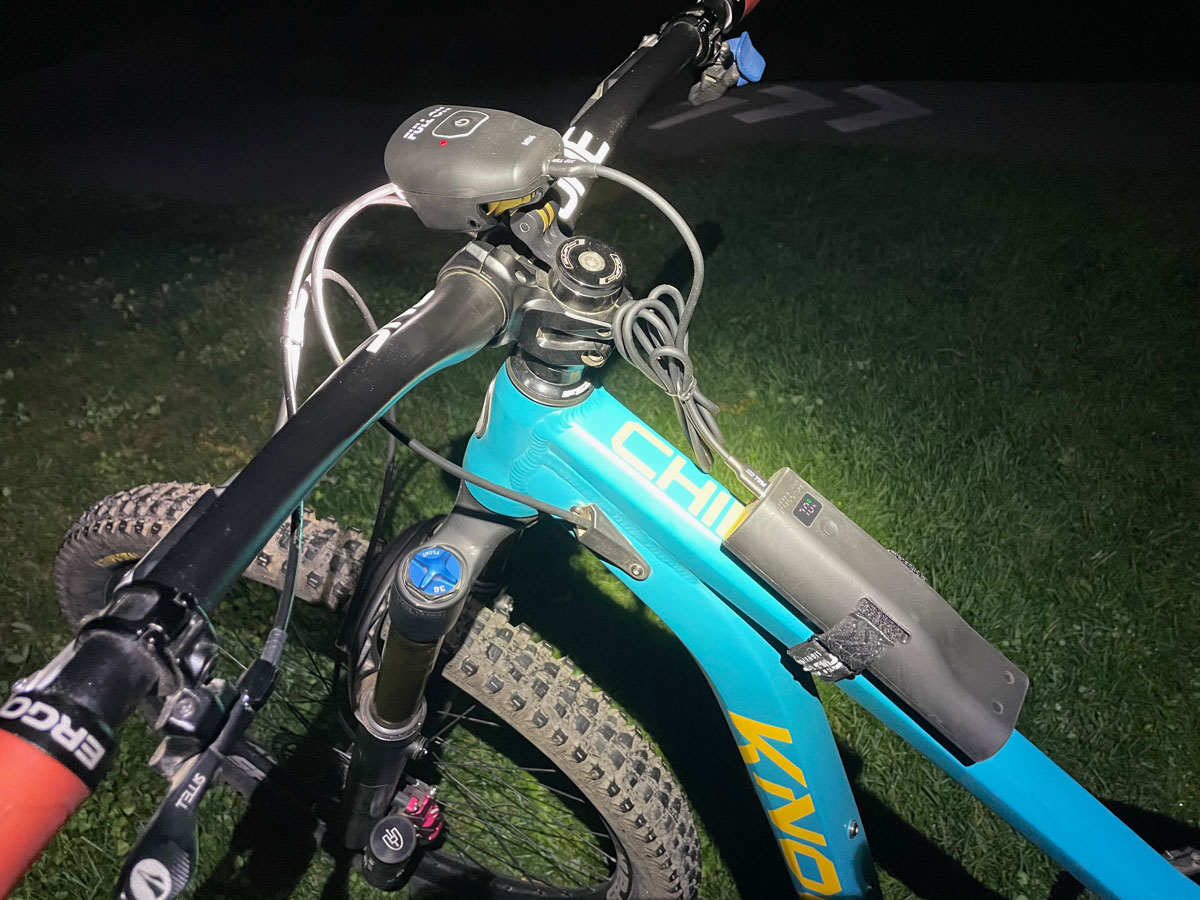
Now I’ve already noted that riding with a light (or the brighter of two) on my helmet is my preference, but I did several rides with the MB6 on my stem as well. On the stem mount, the light can’t look upwards or downwards, and it lights up whatever your handlebar is pointed at. Thankfully, the MB6’s beam is wide enough that many riders may be perfectly happy with it on their stem. Even as your handlebars sway left and right during technical uphills, you can always see where you’re headed.
Even in Low mode on the stem mount, the MB6 is bright enough for climbing, but well-defined trail visibility is limited to about 20-30 feet. I was impressed when I noticed the MB6’s wide beam lights up everything from my fork to well above head height on the trail ahead, with trees lit up easily 50-60 feet away.
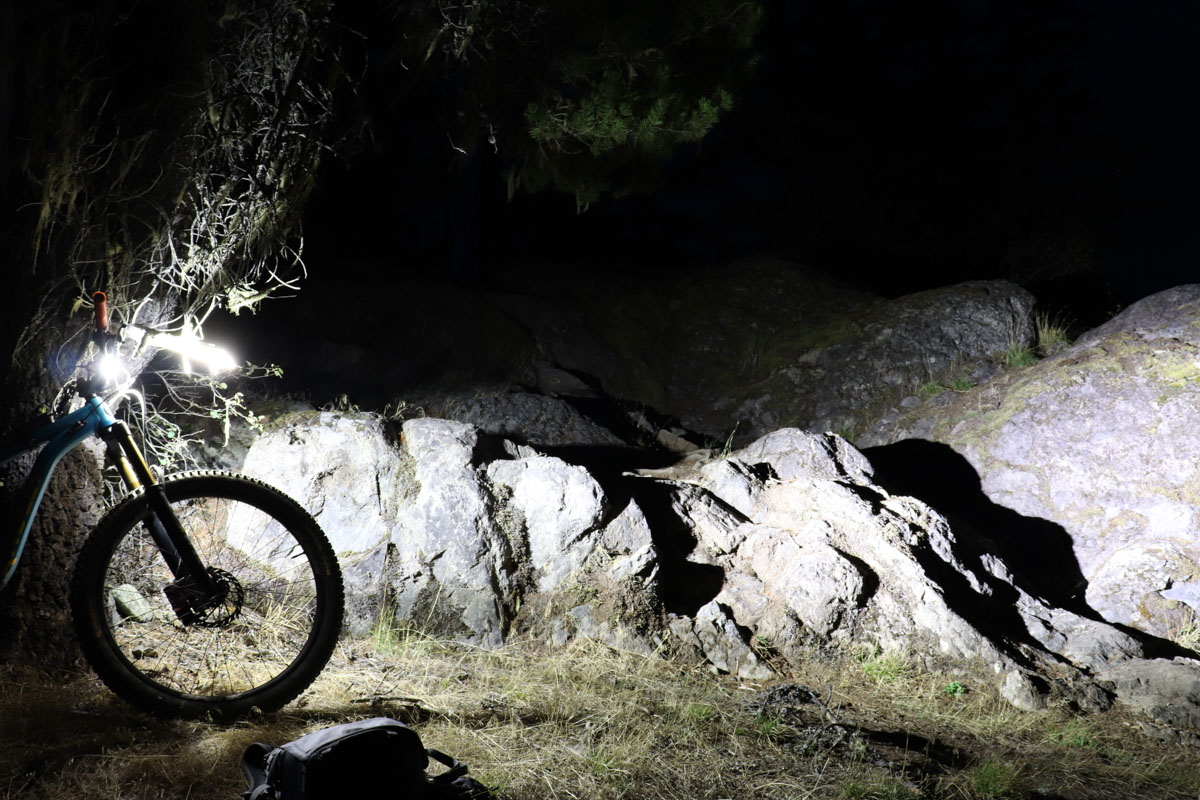
Stepping up to Manual High mode, I easily had enough visibility pretty far up the climbs. In this mode, I could clearly see obstacles in the trail from at least 40-50 feet away, and again, the increased output brightens up the MB6’s side beams much better than Low mode. To no surprise, ALC mode increases overall visibility even more, and even fixed on the stem, it lights up enough area that it’s hardly necessary for climbs.
Now, back to the fun part – descending! I found Manual High mode on my stem more than ample for full speed downhill runs. 3800 lumens is plenty of light, so despite the light’s fixed position, I was comfortable riding full tilt in the darkness. While a second light can’t be beat in this regard, the MB6’s wide beam did light up corners well enough to get me through without hesitation.
Riding downhill in ALC mode is noticeably brighter than Manual High mode, and is easily good enough for full pace runs. In most scenarios, any rider would be happy with the visibility afforded by ALC mode from the stem mount.
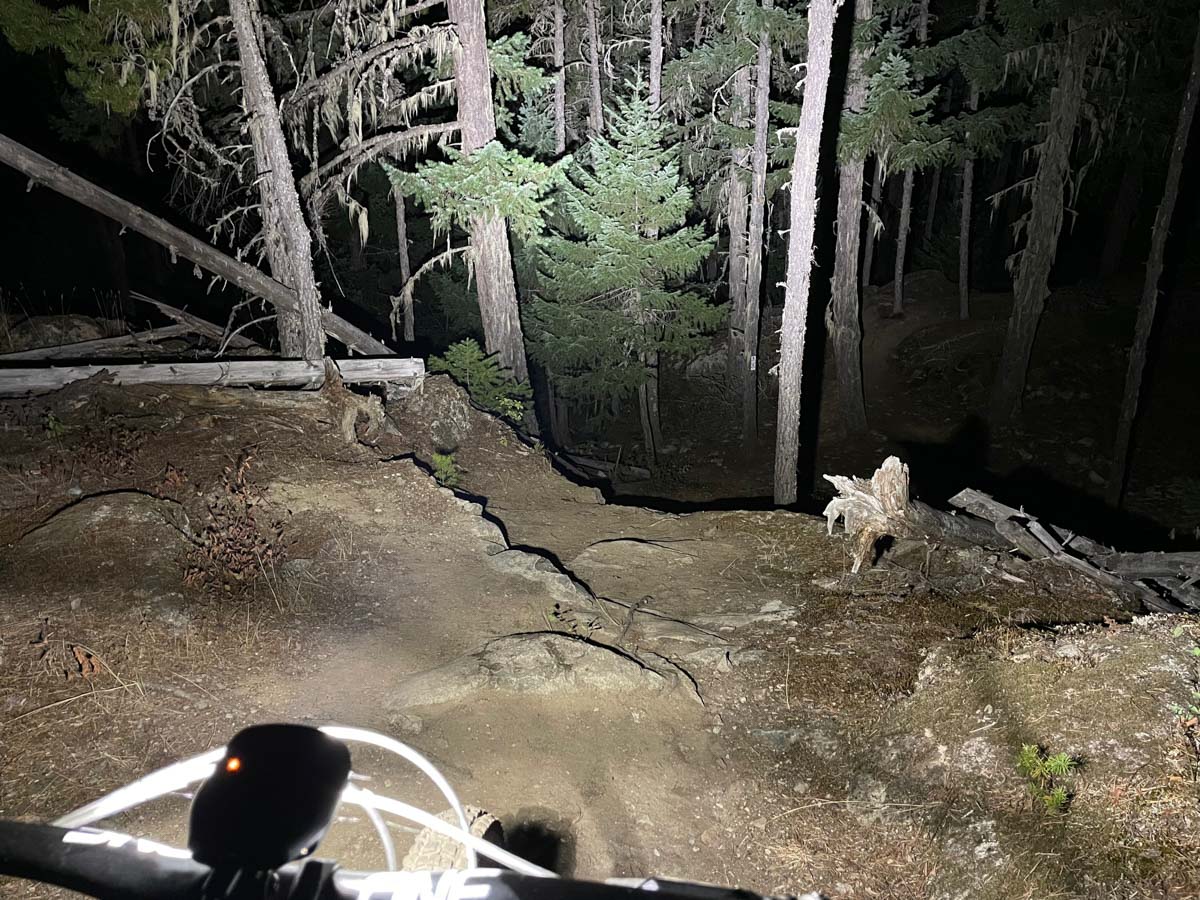
I only found one instance where I decided against riding an advanced feature with the MB6 on my stem. On fairly level terrain, the MB6’s beam will light up the trail immediately below you, but I came to a rock slab with a small step-down gap in the middle. As I crept down the slab, I still couldn’t get light on the landing, which was well below me. I opted not to hit the gap, but I suspect if I had the MB6 on my helmet, I would have done it. From a higher angle, and tilting with my head, the light would have been able to shine downwards at the landing. Of course, you could just skip gnarly features like this at night… but where’s the fun in that?
My only issue with the stem mount is that the light does shake around a lot while you’re riding rougher trails. The MB6’s beam is wide and bright enough that you don’t really lose visibility, and can definitely still ride full tilt in pitch black. But, running the light on your helmet reduces the shaking. The light’s beam doesn’t dance around nearly as much and is less distracting to the eyes.
One Light vs. Two:
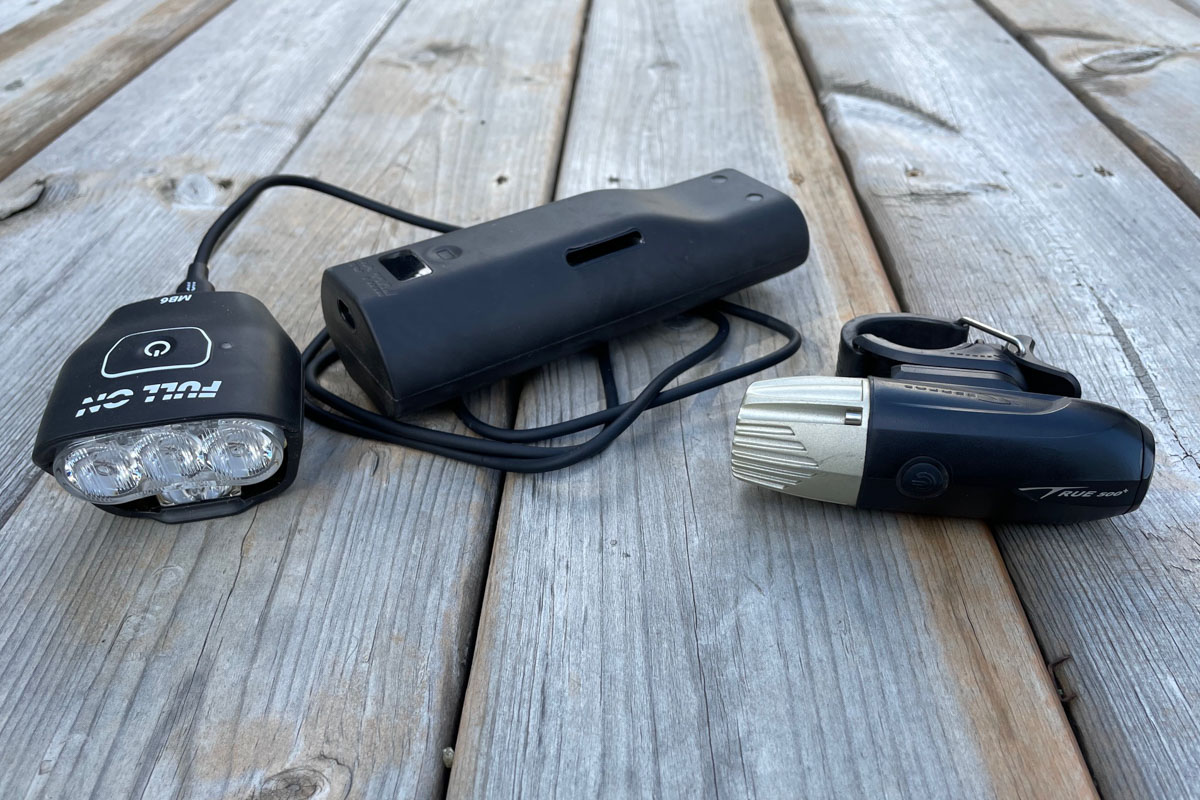
Even though the MB6 has more than enough light output to ride with on its own, I still prefer riding with a second light. Regardless of whether you run the more powerful light on your head or handlebars, two is simply better than one. Cornering is the most obvious advantage; The light on your head can look into them sooner, and will illuminate the trail better than the periphery of one broad beam light. I also noticed that even with the MB6 on Manual High, I could still clearly see where my Serfas True 500 was shining when it wasn’t lined up directly with the MB6’s beam.
While 1500 lumens from the MB6 did the job for climbing, adding my smaller light at 400 lumens still made a big improvement. It reduces the feeling of focusing on one light source and allows you to look around while you climb. It also helps me feel a bit safer when I’m out riding solo in the middle of the night, and I think it’s crazy not to ride with a backup light in case one shuts down on you!
Battery Life:
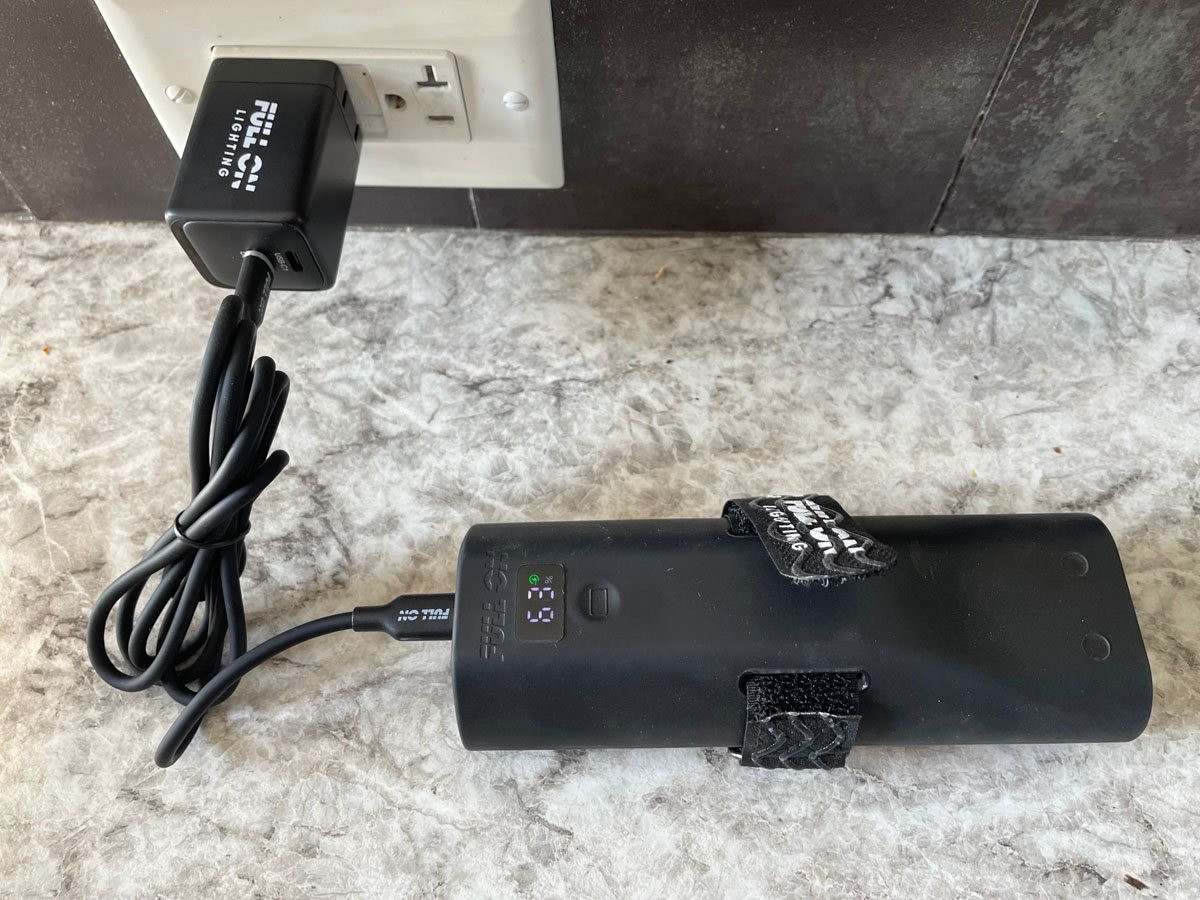
When I tested the MB6’s battery life in Manual High mode, it actually slightly outperformed Full On’s claims. They say it should last two hours, and after one hour of riding, I went down from 100% to 56%. However, after 1.5 hrs, I was still at 36%. Nice!
That said, I did not achieve anything close to the 2.5 hours maximum Full On claims for ALC mode. On several rides with different modes in play, it seemed ALC mode was draining the battery quite quickly. I did one test ride entirely in ALC mode, and after 1:25, I had used 85% of the battery. On another ride, ALC mode killed the battery from 31% in roughly 35 minutes.
Since Low mode takes 6 hours to drain, and I couldn’t bench test the light due to it heating up, I didn’t do a full test in Low. After climb testing in Low mode, I can confirm it does not drain the battery much. About an hour of climbing only ate up 13% of the juice.
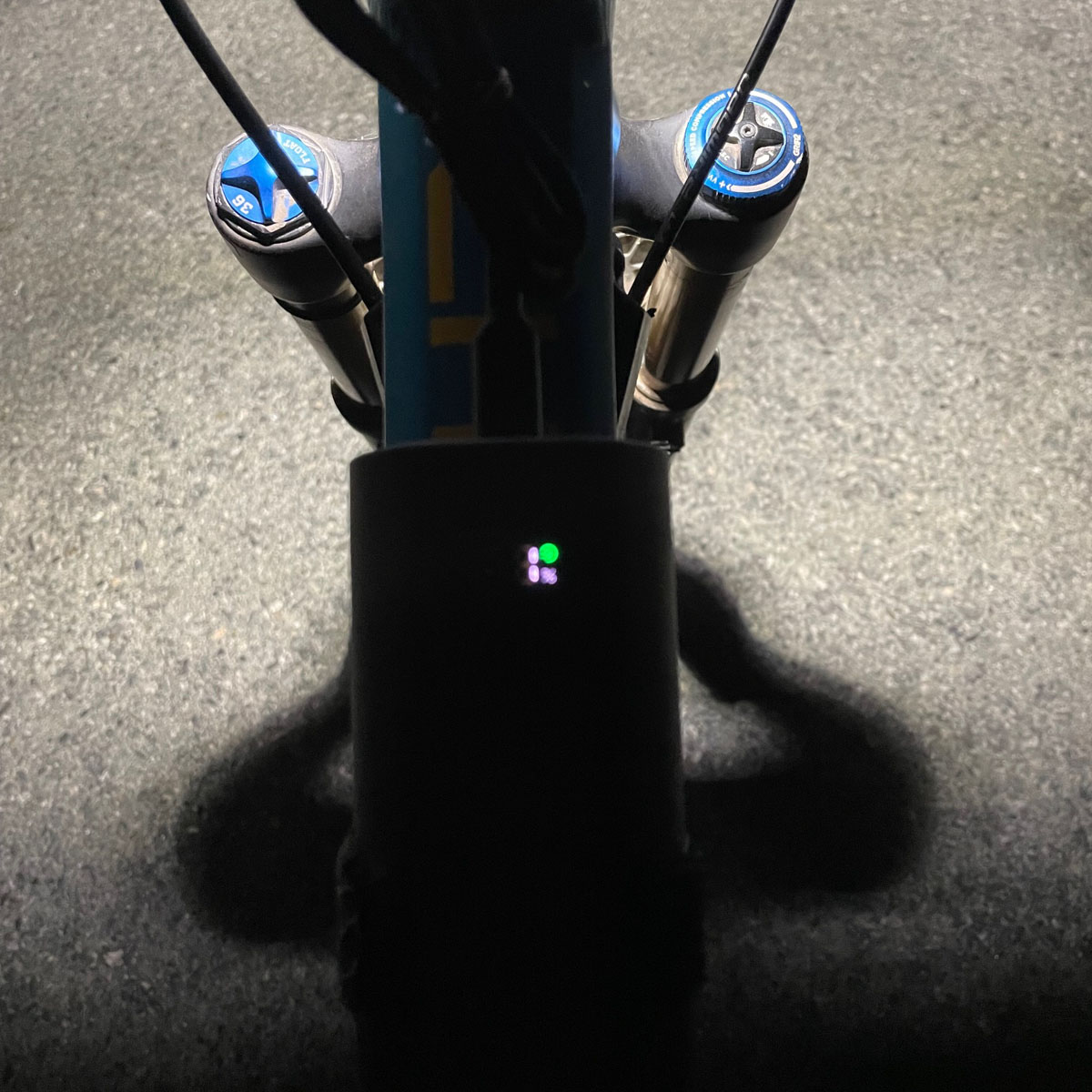
Aside from the battery’s display, the MB6 does not give any kind of low-power warning before shutting off. The display’s numbers start flashing at 5%, and on my test run, the battery died quickly after.
If you run the MB6 on your helmet, you have to remember that the battery life can’t be monitored with the battery in your pack. It would be great if the MB6’s beam perhaps flashed to warn you of low power, or even if the light beeped to let you know.
Mounting:
For my helmet-mounted rides, I used my Endura MT500 lid to test the MB6 light since it has a clip-on GoPro mount (see photo above). I had no issues at all with the MB6’s helmet mount – it held the light securely. Also, the longer cable is easily long enough to reach the battery deep down in your pack.

Full On’s steerer tube mount did great, and I like how it centers the light over your stem! The MB6 did not budge at all after several rides on rough trails. Even with the shorter cable, I twist-tied up a portion of it as my frame allows the battery to sit pretty close to the light. My bike’s cables/hoses are in the light’s path, but they don’t wind up being a distraction. The light shines around them enough that their shadows are easy to ignore.
The battery’s mounting strap allows some sideways wiggling, but the battery didn’t move around or slip backwards on my frame while I rode. Initially, I brought a spare strap with me, but I never wound up using it. My Knolly Chilcotin’s frame does have a flattened top tube, so it was an ideal mounting scenario.
After several rides with the battery strapped to my top tube, there is no damage to my frame’s paint or finish. It’s safe to say you’d have to do a lot of riding with the battery on the frame before paint wear would even potentially be an issue.
Other Observations:
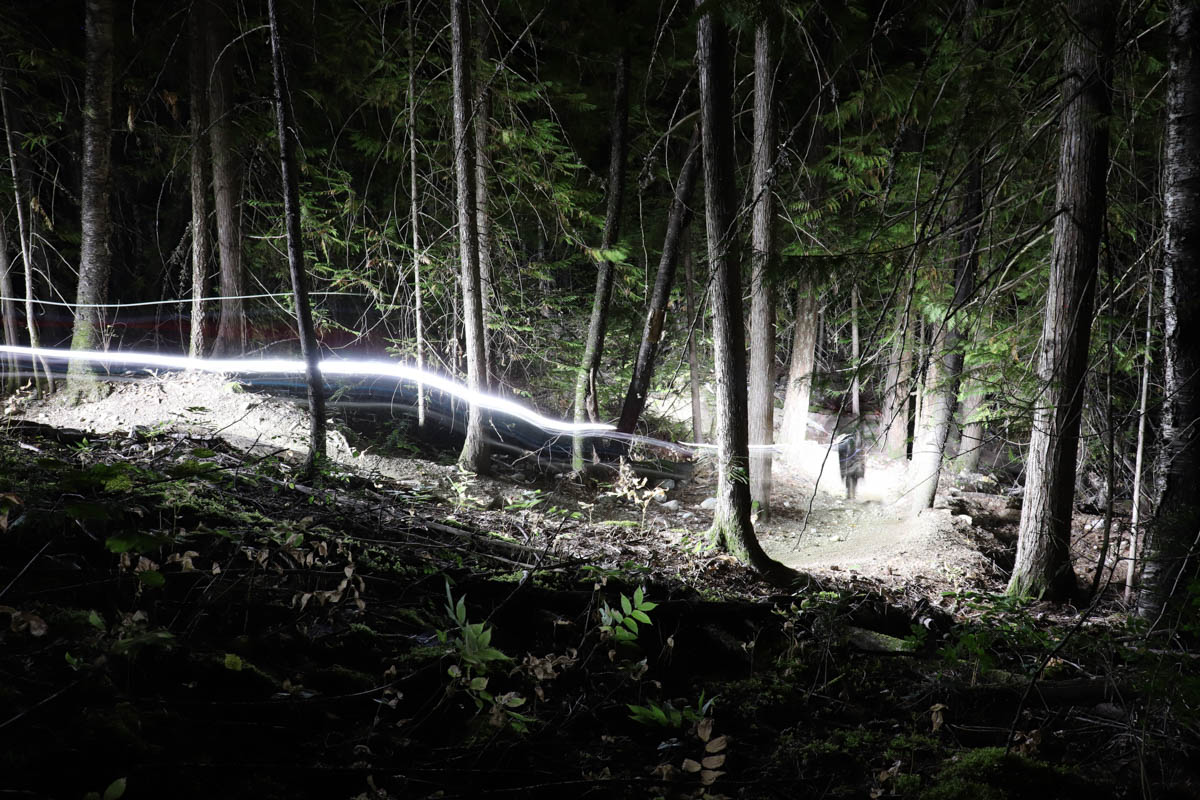
Something I noticed and liked right away was how the MB6’s light is very white. It is much whiter than my Serfas True 500’s beam, which appears more yellow.
One thing I find odd is that the MB6 can only achieve its full 6000 lumen output when in ALC mode, and you never really know how much output you’re actually getting. Interestingly, I never noticed the light output changing while I rode in Active Light Control mode, despite its capability of ranging from 1500-6000 lumens. Thankfully, ALC mode was always easily bright enough for full tilt night riding. I still wonder, though, why not offer a manual mode that stays at 6000, or even 5000 lumens?

When mounted to your helmet, the button on the MB6 is not super easy to find with gloves on. It’s not terribly difficult, but having a more defined edge around it would be great. On one ride, I did pull my glove off after fumbling around looking for the button. Without gloves, your fingers can find the button easily.
I felt around the MB6 after a two-hour ride, and even with my bare hands, I could not find anything too hot to the touch. I imagine the cooling fins could potentially get pretty hot, but the plastic-covered parts of the light were just slightly warm. However, I ran the light in Manual High mode on my table for just a few minutes, and when it’s not exposed to wind, it heats up fast! The cooling fins got very hot quickly, so this light could get dangerously hot if left running while not moving.
Update:
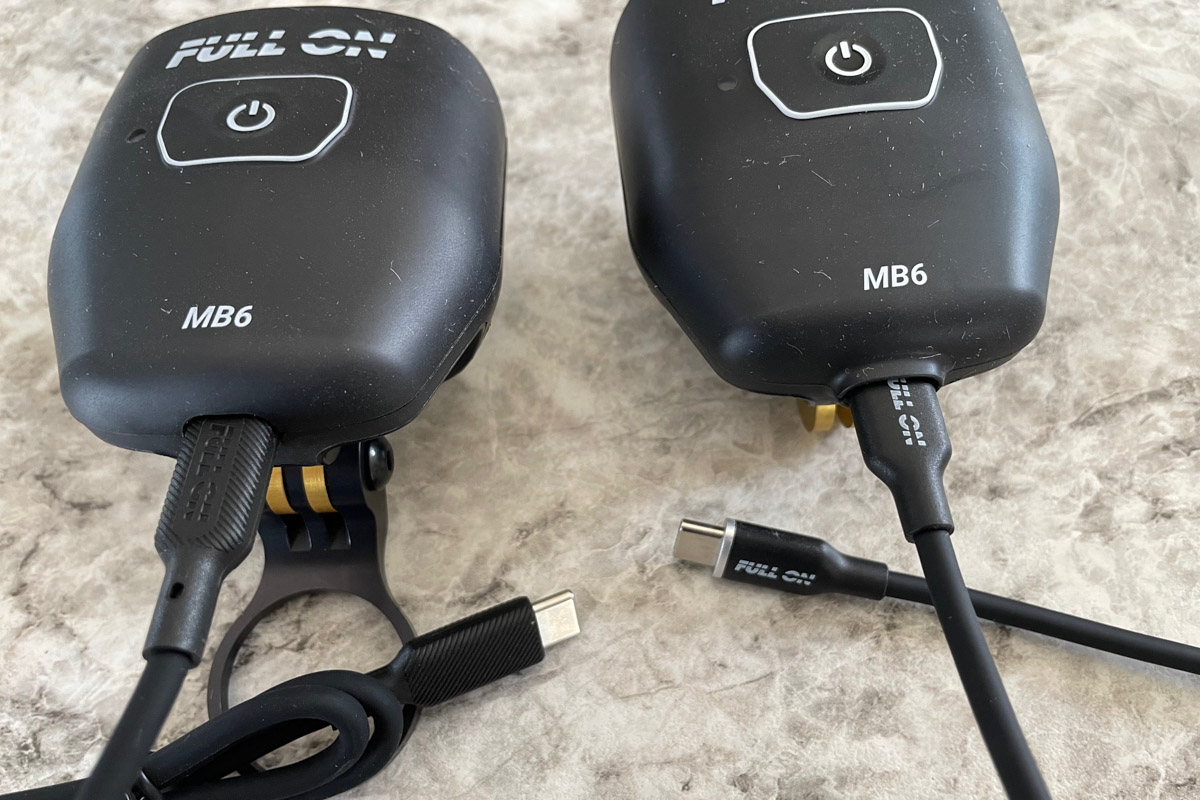
Just before I wrapped up my review, Full On informed me they had made updates to the MB6. Thankfully, they didn’t change much, as this article was 99% finished! While they never said it was actually a problem, I was told some customers were concerned about the power cable coming out of the light on the trail. In response, Full On added a lip to the light housing where the cable connects, and slightly enlarged the cable ends. After receiving an updated light and cable, I’ll confirm this did make for a tighter fit. However, I never had any issues with the cable disconnecting on my light. To alleviate taller riders’ concerns, they also added 10cm of length to the longer cable. At 5’10”, I found the 48” cables long enough, but it’s nice to see Full On actively responding to customer feedback.

MSRP for the Full On MB6 light kit is $355. The light is covered by a three-year warranty.

